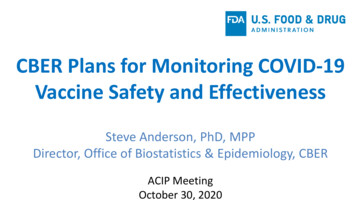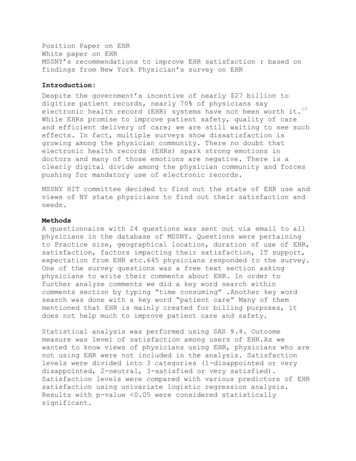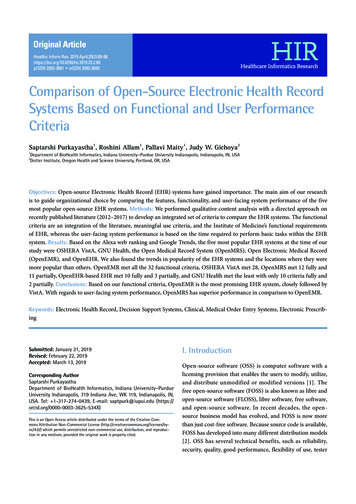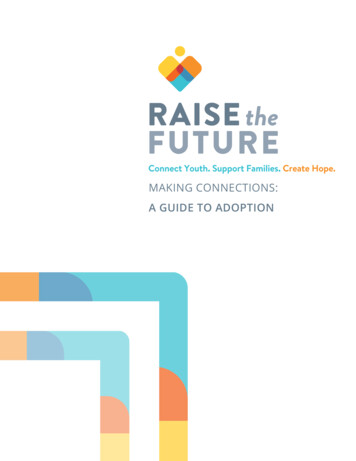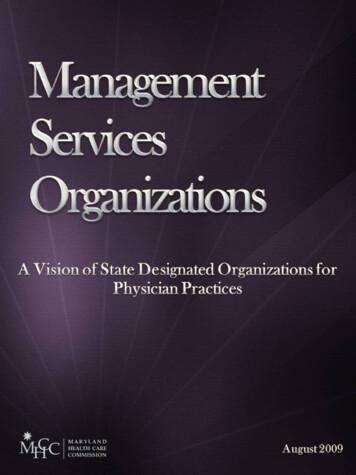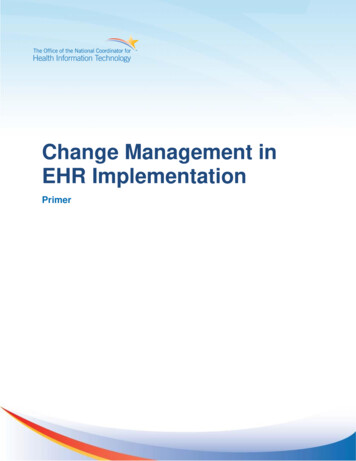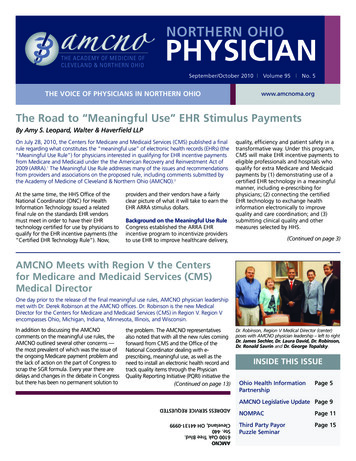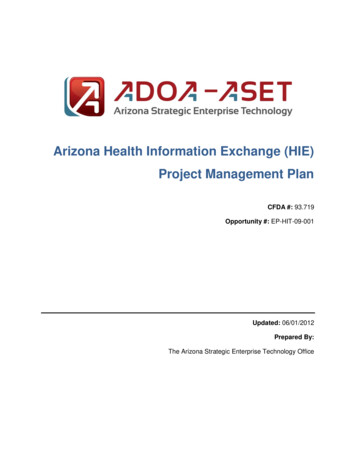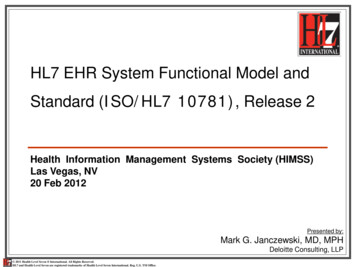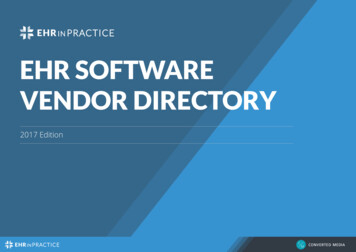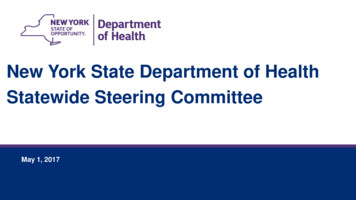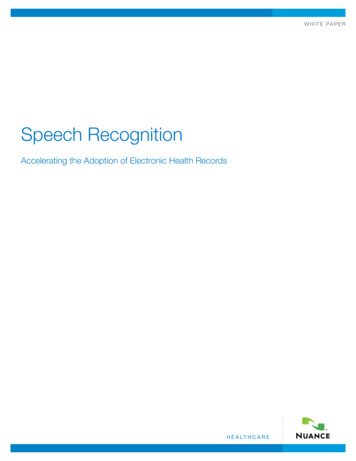
Transcription
w h i t e pa p e rSpeech RecognitionAccelerating the Adoption of Electronic Health Recordsh e a lt h c a r e
ContentsSummary. 3Forces Are Driving the U.S. Towards Electronic Health Records. 4Yet EHR Templates Slow Physicians Down. 4Physicians Agree: Speech Makes EHR Systems Faster and Easier to Use. 5Major Health Systems Use Speech Recognition. 6Benefits are Substantial. 6Speech Recognition Supports Many Physician Documentation Styles. 7Freedom of Speech Will Increase Chances of EHR Success. 8Conclusion. 8EHR Vendors Embed Speech into Their Products. 9Case Study: Advocate Illinois Masonic Medical Center. 102
SummaryThe rush to adopt Electronic Health Records (EHR) is on. Funding for those who qualify under theMedicare and Medicaid Electronic Health Records Incentive Programs under the HITECH provisionsof the 2009 American Recovery and Reinvestment Act can run up to 44,000 for Medicare, and upto 64,000 for Medicaid—and millions of dollars per hospital when implementing an EHR systemthat is on ONC’s official Certified Health IT Product List (CHPL). This list includes EHR technologiesthat have been tested and certified as being technically capable of supporting those providers’achievement of meaningful use based on Stage 1 criteria outlined in HHS rules, and have it deployedto meet time-phased reporting requirements.Practices around the country are faced with the challenge of getting their physicians to documentpatient care in the EHR. But did you know that speech-enabling your EHR system can actuallyincrease EHR adoption amongst physicians, improve their efficiency within the system, andultimately allow them to provide better patient care?This white paper identifies forces both driving and inhibiting EHR adoption. EHR systems’inflexibility and other limitations often prevent them from being used effectively by a broad range ofphysicians—without help from enabling technologies.Speech recognition is one such technology. It has proved effective at helping physicians create electronichealth records. Today, over 400,000 clinicians use voice recognition to dictate findings into electronicrecords—far more than those documenting findings solely via typing or ‘mouse clicks.’ Speechrecognition allows physicians to capture anywhere their observations, assessments, and plans for readyaccess within the EHR.In addition to speech recognition, innovations are being developed to understand the full meaning ofspeech-captured data, such as Clinical Language Understanding (CLU) solutions. These advanceswill facilitate the extraction of structured, actionable information from unstructured dictation to meetmeaningful use requirements, ICD-10 standards, and ensure that the document is coded completelyfor revenue cycle management processes.The benefits of speech-enabled EHR systems include: Dramatically reduced transcription expense. Substantially improved physician experience. Improved patient care via complete documentation that is immediately available. Reduction in time spent documenting care. Increased per-patient revenue by enabling physicians to document a more complete patient note.Some speech recognition solutions offer physicians multiple methods by which to dictate—a criticalrequirement. While all physicians in a department or practice might use the same clinical system,they may have widely different styles of documentation, which EHR systems alone cannot address.As more EHR systems become web-enabled, new speech platforms will be needed to serveclinicians in an ‘on demand’ manner, offering all dictation modalities as a web service. The EHRvendors with the largest market shares support the seamless use of speech recognition within theirapplications, further accelerating EHR adoption.Further, as more and more health systems are deploying EHRs within virtualized desktops or cloudbased architectures, so have speech technologies kept pace—with exciting advances in the works.3
Forces Are Driving the U.S. TowardsElectronic Health Records.The era of Electronic Health Records is finally on the horizon.What’s driving U.S. healthcare towards EHR adoption? Federal government initiatives. The American Recovery andReinvestment Act (ARRA) of 2009 included, according to currentestimates, as much as 27 billion over ten years which will beexpended to support adoption of electronic health records(EHRs). Under the Health Information Technology for Economicand Clinical Health Act (HITECH), federal incentive payments willbe available to doctors and hospitals when they adopt EHRsand demonstrate use in ways that can improve quality, safety,and effectiveness of care. Eligible professionals can receive asmuch as 44,000 over a five-year period through Medicare. ForMedicaid, eligible professionals can receive as much as 63,750over six years. Medicaid providers can receive their first year’sincentive payment for adopting, implementing, and upgradingcertified EHR technology, but must demonstrate meaningful use insubsequent years in order to qualify for additional payments.1 A change in reimbursement philosophy. U.S. healthcare isevolving from ‘fee for service’ to ‘pay for quality’ and ‘pay forperformance.’ Private and government payors base a portionof reimbursement on measurable outcomes. EHR systems areneeded to keep score. Substantially improved patient care. Prior studies by theInstitute of Medicine have determined that many medicalerrors occur because of a lack of universal access to patientdocumentation. Leveraging speech recognition technology,physicians can infuse the patient record with their directobservations, assessments, and plans—in their own words.Having patient notes immediately available in the EHR meansthat all members of a patient’s care team have access to up-todate, complete information—meaning better decisions and betterpatient care.“Interviewees reported thatmost physicians using EHRsspent more time per patient for aperiod of months or even yearsafter EHR implementation. Theincreased time costs resultedin longer workdays or fewerpatients seen, or both, duringthat initial period ”“Most respondents or theircolleagues considered evenhighly regarded, industry-leadingEHRs to be challenging to usebecause of the multiplicityof screens, options, andnavigational aids. Problems withEHR usability—especially for documentingprogress notes, causedphysicians to spend extrawork time to learn effectiveways to use the EHR. Thesesubstantial initial time costs arean important barrier to obtainingbenefits, as greater burdens onphysicians’ time decrease theiruse of EHRs, which lowers thepotential for achieving qualityimprovement. ”Physicians’ Use OfElectronic Medical Records:Barriers And SolutionsRobert H. Miller and Ida Sim, UCSFHealth Affairs Magazine Yet EHR Templates Slow Physicians DownMost physicians say that EHRs slow them down and prevent them from documenting care in amanner that accurately depicts the patient encounter.“Much of the meaning and inference that can be gleaned by the clinician through the use of narrativeis lost when a rigidly structured template is used, and the ability to communicate complex ideasin an efficient and fluid manner diminishes,” notes Jason S. Shapiro, MD, of Columbia University’sDepartment of Bioinformatics.1. For more information on the HITECH Act, please visit http://healthit.hhs.gov/portal/server.pt4
Experienced EHR users agree. “Although our EHR system is an exceptional product, you cannotmake a template to cover every situation and scenario,” said Steve McCullough, MD, a nephrologistbased in Paducah, Kentucky, and a strong advocate and user of electronic medical records in hisinternal medicine practice.A study performed by UC Davis School of Management and released in December 2010 determinedthat the initial implementation of an EHR system resulted in 25% to 33% drop in physician productivity.While some information is necessarily captured via ‘point and click’—choosing from a list ofmedicines or allergies—documenting the substance of an encounter requires the physician to usehis or her own words. Clinical findings, history of the present illness, patient descriptions, pastmedical and social history, assessment and plan, as well as referral letters and consult notes, allrequire that the physician ‘dictate’ using unrestricted free text.Physicians Agree: Speech Makes EHR SystemsFaster and Easier to UseFor the U.S. healthcare system to gain the benefits of electronic records, physicians must broadlyadopt computerized medical systems. Speech recognition is one technology that offers an invitingon-ramp for clinicians to drive EHR systems. Speech recognition technology has been shown to: Help physicians use EHR systems without changing their documentation methods. Convert EHR systems into a quality-of-care-enhancing and revenue-enhancing technology.This finding was supported by a report issued by KLAS (www.klasresearch.com) identifying that: Three-quarters (76%) of the clinicians using ‘desktop’ speech recognition—directly controlling anEHR system via speech—report faster turnaround time, better service to patients, and fasterreimbursements as the greatest benefits. Nearly 3 in 10 (33%) cite sharply reduced costs and increased productivity as other benefits.Cost savings from EHRs are realized by both reductions in transcription and overhead associatedwith the billings and collection process.“Dragon Medical Practice Edition lets me describe the patient encounter in my own words,”says Dan Field, MD, an emergency physician for Kaiser Permanente in Northern California. “It’sembedded in our EHR system so I can use free-text dictation anywhere. I can also quickly navigateto different parts of the chart using my spoken commands.”Clearly, physicians find EHR systems more effective when driven by speech.“If I didn’t have speech recognition, I couldn’t use the EHR. I can’t type, and I’m not going to ‘pointand click’ all day. Speech recognition and an EHR is the ideal combination,” says Andrew Fireman, MD,a cardiologist at AMS Cardiology, a 17-physician practice in Abington, Pennsylvania, which uses theeClinicalWorks EHR.Speech recognition software can be customized to record voice macros—pre-defined templateswith standard elements to guide the physician’s documentation—which can also keep physicians incompliance with guidelines established by the Centers for Medicare and Medicaid Services (CMS).These voice macros are easy to create and are an important time-saving feature.5
Major Health Systems Use Speech RecognitionClinicians at many of the leading healthcare delivery networks rely on Nuance Healthcaresolutions to document patient encounters, including:100% of the U.S. News & World Report Honor Roll Hospitals192% of the Most Connected Hospitals294 of the Top 100 Hospitals3These healthcare providers have recognized the positive impact of speech recognition on thequality and cost of care and have deployed speech recognition for use by its clinicians:Advocate HealthAtrius HealthBanner HealthBarnes-Jewish Hospital/Washington UniversityBaylor Health Care SystemBrigham and Women’s HospitalCatholic Healthcare WestCleveland ClinicDartmouth-Hitchcock MedicalCenterDuke University Medical CenterGroup Health CooperativeHealth PartnersIntermountain HealthcareThe Johns Hopkins HospitalKaiser PermanenteLahey ClinicLifetime HealthThe Mayo ClinicNew York-Presbyterian HospitalNYU Medical CenterPartners Healthcare ProvidenceHealthStanford Hospital and ClinicsSt. Joseph’s HealthcareUCLA HealthcareUnited States Air ForceUnited States ArmyUnited States NavyUnited States VA HospitalSystemUniversity of California,San Francisco Medical CenterUniversity of Michigan Hospitalsand Health SystemUniversity of PennsylvaniaHealth SystemUniversity of Pittsburgh MedicalCenterUniversity of Virginia HealthSystemUniversity of WashingtonMedical CenterUSC—Keck School of MedicineSutter HealthWellspan1. America’s Best Hospitals: The 2011 – 2012 Honor Roll, U.S. News & World Report2. 2011 Most Connected Healthcare Facilities, HealthImaging.com3. America’s Top Hospitals, 2011, U.S. News & World ReportFrequently-accessed information and frequently-visited parts of an EHR can easily be accessed withmacros, or by speech-enabling the EHR system.Benefits Are SubstantialSpeech-driven EHR users report the following benefits: Reduced transcription expense. EHR systems driven by speech can enable clinicians to dictate substantial sections of themedical record in ‘free-text’ directly into the EHR, using their own words, without having torely on transcription. Speech-driven EHR systems can reduce or eliminate the ongoing cost oftranscription by providing physicians greater flexibility to document findings. Dramatically increased physician productivity. Studies show that the average physician spends up to 15 hours a week documenting encounters.The average encounter takes three to four times as long to document in an EHR using keyboardand mouse as it does to dictate. Speech recognition systems reduce time-on-documentation byas much as 50%—freeing up the physician to spend more time with patients.6
Improved patient care via more detailed documentation and faster results delivery. Patient notes created via speech contain deeper and more descriptive information—vital detailneeded for a complete patient assessment. The immediacy of information means that treatment plans are formulated more rapidly, reducing thechance of adverse medical effects. Increased cash flow and revenue. A recent study by Fallon Clinic (Worcester, MA) measured the impact of speech recognition onclinical workflow and quality of care and found substantial opportunities to maximize reimbursementper physician using speech recognition with an EHR.“ We have saved enough on transcription costs using Dragon Medical Practice Edition to pay for thesoftware many times over,” says Kaiser’s Dr. Field. “Dragon Medical Practice Edition is one of the mostsuccessful cost savings investments I’ve ever seen. We’re expanding its use both in the ED and in otherdepartments across Kaiser.”Speech Recognition Supports Many Physician Documentation StylesUnderstandably, physicians exhibit a wide range of comfort with using medical software. WhilePhysician A may readily adapt to controlling an EHR by speech, Physician B may resist abandoningstandard dictation. Similarly, some clinicians may be comfortable using ‘point and click’ methods—withsome keyboard use—to run their EHR, while others feel that typing takes their attention away from thepatient—or changes their thought process.Technology has evolved to offer clinicians a range of documentation methods—from traditional toautomated– to capture anywhere patient data by speech recognition.These methods include: Manually–driven EHR, where clinicians use neither traditional nor speech-assisted transcriptionservices within the EHR for creating free-text narratives. In this instance, clinicians become typists.While transcription savings are significant, they are more than overshadowed by the often significantreduction in physician productivity. Traditional transcription. A clinician dictates into a microphone or standard telephone, which isthen transcribed by a medical transcriptionist before being released for review and signature byclinicians in the EHR systems. Traditional dictation is the most labor-intensive and therefore the leastcost-effective method of documenting findings in an EHR. Speech–assisted transcription, in which a clinician’s dictation is captured and ‘recognized’ by aspeech recognition engine as a first-pass step. The initial recognition is then reviewed, edited, andcorrected by a Medical Transcription Editor (MTE) and then released for review and signature withinthe EHR. Studies have shown that this ‘back end’ (i.e., in the background) speech recognition, inconjunction with manual editing after the initial recognition has been completed, reduces the cost ofcreating medical records vs. traditional transcription by as much as 50%. Speech–driven or speech-enabled EHRs, where clinicians can dictate directly into free-text fieldsof the EHR and observe their findings on the screen, and can make edits as needed. This ‘front end’approach represents the fastest and most cost-effective method for clinicians to document findings,requiring far fewer process steps (see graphic following). Voice macros—allowing clinicians to navigateany EHR system with a single voice command—improve ease of use immensely.7
Physicians Require a Choice of Documentation MethodsClinicians point, click and type toenter patient information in EHRManually Driven EHRTraditionalTranscriptionDigital DictationTranscribed by n EHRHIGH COSTPost-Processedspeech RecognitionEditedby MTEClinicians drive EHR usingSpeech RecognitionLOW COSTThese four methods are identified in the figure above.Freedom of Speech Will Increase Chances of EHR SuccessWith an expanded range of choices that facilitate EHR use, we recommend that: Physicians should be offered ‘freedom of choice’ within a practice or hospital. Physician Ashould be able to use an EHR system driven by his voice, while Physician B uses a more traditionaltranscription solution where ‘back end’ speech recognition processes physician dictation,presenting the editor with a draft they edit and can upload directly into the EHR for that patient. The speech technologies offered should allow all clinical records to be stored in the sameEHR system, regardless of how they were created.ConclusionA perfect storm of prevailing market winds and advances in technology is poised to usher in thelong-awaited era of electronic health records. The final tack needed to ensure widespread EHRadoption—making EHR software accessible to physicians in a way which supports their documentationpreferences—is now within reach.Physician surveys confirm that speech technology is an essential technology which makes EHRsystems accessible and user-friendly—and improves clinician satisfaction.“Not having patient notes in the appropriate charts at ‘point-of-care’ affected our workflow andcreated significant difficulty with cross-coverage and ongoing patient care,” said Betty Rabinowitz,MD, Associate Professor of Clinical Medicine, University of Rochester School of Medicine (URMC).“Now, using Dragon Medical Practice Edition, physicians articulate the thought process behind theirdiagnostic and therapeutic decisions.We believe the presence of unique narrative sections that arespecific to the patient and the encounter enable URMC to provide the best patient care.”8
EHR Vendors Embed Speech into Their Products Epic Systems (www.epic.com) supports Dragon Medical Practice Edition with its EpicCare EHR system. “I use Dragon Medical Practice Edition daily to perform all of my medical documentation. We see asignificant workflow efficiency advantage when a physician can document directly into our EpicCareEHR We also leverage Epic’s intrinsic charting tools with voice by building custom commands inDragon Medical Practice Edition to voice activate those charting tools This can reduce the numberof ‘mouse clicks’ to complete a particular section of the EHR.”—Robert Frank, MD, Epic andDragon Medical Practice Edition user, Advanced Healthcare, Milwaukee, WI Cerner Corporation (www.cerner.com) supports Dragon Medical Practice Edition for use with itsPowerNote physician documentation solution.“ We’ve been using Dragon Medical Practice Edition alongside our Cerner EMR and have seensignificant benefits. Not only are clinicians empowered to complete comprehensive, high quality notesin real-time by speaking, but the optimization has simplified problem diagnosis and repair, improvedrecognition accuracy Dragon Medical Practice Edition works very well within a Citrix-based EHRenvironment. On average, I’ve been able to save 30 minutes per day on documentation ”—Steven H. Zuber, MD, Chief Medical Information Officer, Cerner PowerNote andDragon Medical Practice Edition user, Nebraska Methodist Allscripts (www.allscripts.com) supports Dragon Medical Practice Edition for its Enterprise EHR andSunrise Clinical Manager, and Dragon Medical Practice Edition for its Professional and MyWay solutions.“ It’s a lot of fun. I really enjoy it and have probably saved about 20,000 in the last two years in transcriptioncosts.”—Steven McCullough, MD, Allscripts Enterprise and Dragon Medical Practice Edition user, WesternKentucky Kidney Specialists, Paducah, KY eClinicalWorks (www.eclinicalworks.com) a provider of EHR and practice management solutions,supports the use of supports the use of Dragon Medical Practice Edition andDragon Medical 360 Network Edition for physician documentation. “Dragon Medical Practice Edition works great for me—I can’t type—I use eClinicalWorks for a lot of‘point and click,’ but for the subjective information, as well as my conclusions and impressions, that’swhere Dragon Medical Practice Edition shines. I would never go back to life pre-Dragon.”—BruceBerger, MD, Cardiologist, eClinicalWorks and Dragon Medical Practice Edition user, AMS Cardiology,Abington, PA NextGen (www.nextgen.com), a provider of integrated practice management and EHR systems, hasfound that its customers document more efficiently with Dragon Medical Practice Edition andDragon Medical 360 Network Edition.“ At my former practice, I felt the pain of dealing with this total ‘point and click’ world. The dreamof speaking into the note instead of typing to supplement my ‘point and clicks’ is now becoming areality. With Dragon Medical Practice Edition, the note stares me in the face so I’m able to recognizethat I’ve documented appropriately, and, if appropriate, I can bump the code level up to where itbelongs.” —Douglas Golding, MD, Medical Director and Chief of Healthcare Informatics, NextGen andDragon Medical Practice Edition user, Lifetime Health Medical Group, Buffalo, NYDragon Medical Practice Edition works with hundreds of other EHR software packages, including thoseoffered by MEDITECH , GE , McKesson , Siemens , athenahealth , and many others.9
Case Study: Advocate Illinois Masonic Medical CenterPowerNote , developed by Cerner Corporation, is one of the most widely used EHR modulesin hospitals and integrated delivery networks. Dragon Medical Practice Edition speechrecognition technology is used with PowerNote by over 15,000 clinicians, who use computergenerated templates to create patient documentation. Using Dragon Medical Practice Edition,PowerNote has been speech-enabled to improve their ease of use, and in turn, the efficiencyand productivity of medical professionals. Clinicians can use voice macros to select valuesfrom drop-down menus and use free-text dictation when needed.Nearly 600 providers from Advocate Illinois Masonic Medical Center (AIMMC), home to a Level ITrauma Center, a Level III Neonatal Intensive Care Unit, and one of the top health systems inthe U.S., currently use Dragon Medical Practice Edition from Nuance Healthcare within CernerPowerNote, the structured clinical documentation module of Cerner Millennium EHR system.Providers are using Dragon Medical Practice Edition speech-recognition capabilities andspecialty-specific templates. Dragon Medical Practice Edition allows clinicians to documentpatient care directly into PowerNote and maintain full-text control of the dictation. AIMMC hasbeen able to reduce transcription costs and can now focus limited resources on providingexcellent patient care.New speech technology will make EHR software more usable regardless of location or client technology.“I am not a typist,” says Dr. Field. “Every EHR I have worked with requires the skills of a dataentry clerk. When I have to type, I cut corners to save time and clicks on my hands. WithDragon Medical Practice Edition’s speech recognition I capture my patient encounter, deliverexcellent documentation to my colleagues through the EHR, and produce a medical record that willstand up in court, if that should ever be necessary. I can’t imagine using any EHR system withoutDragon Medical Practice Edition.”As speech accelerates physician adoption of EHR systems, the U.S. healthcare system will continueto gain the benefits of slower healthcare inflation, improved outcomes, and higher patient andclinician satisfaction alike.As healthcare organizations deploy EHRs, the challenge they face is how clinicians can continue tocapture the entire patient story, as part of the clinical workflow. Clinical Language Understandingtechnologies are being developed today to convert the patient story into actionable data, which canbe used across the enterprise and adapted into virtually any EHR chosen by a healthcare facility.The next generation of speech recognition solutions promise physicians the ability to capture clinicaldata anywhere, on any device, provide a full understanding of the patient story, and use it for bothclinical and business benefit.About Nuance HealthcareNuance Healthcare, a division of Nuance Communications, is the market leader in providing clinicalunderstanding solutions that accurately capture and transform the patient story into meaningful,actionable information. These solutions are proven to increase clinician satisfaction and HITadoption, supporting thousands of hospitals and providers to achieve Meaningful Use of EHRsystems and transform to the accountable care mode. 2012 Nuance Communications, Inc. All rights reserved. Nuance, the Nuance logo, and Dragon are trademarks and/orregistered trademarks of Nuance Communications, Inc., and/or its subsidiaries in the United States and/or other countries.All other trademarks are properties of their respective owners.10
11
7/12 DTMh e a lt h c a r e
The EHR vendors with the largest market shares support the seamless use of speech recognition within their applications, further accelerating EHR adoption. Further, as more and more health systems are deploying EHRs within virtualized desktops or cloud- . 94 of the Top 100 Hospitals3
